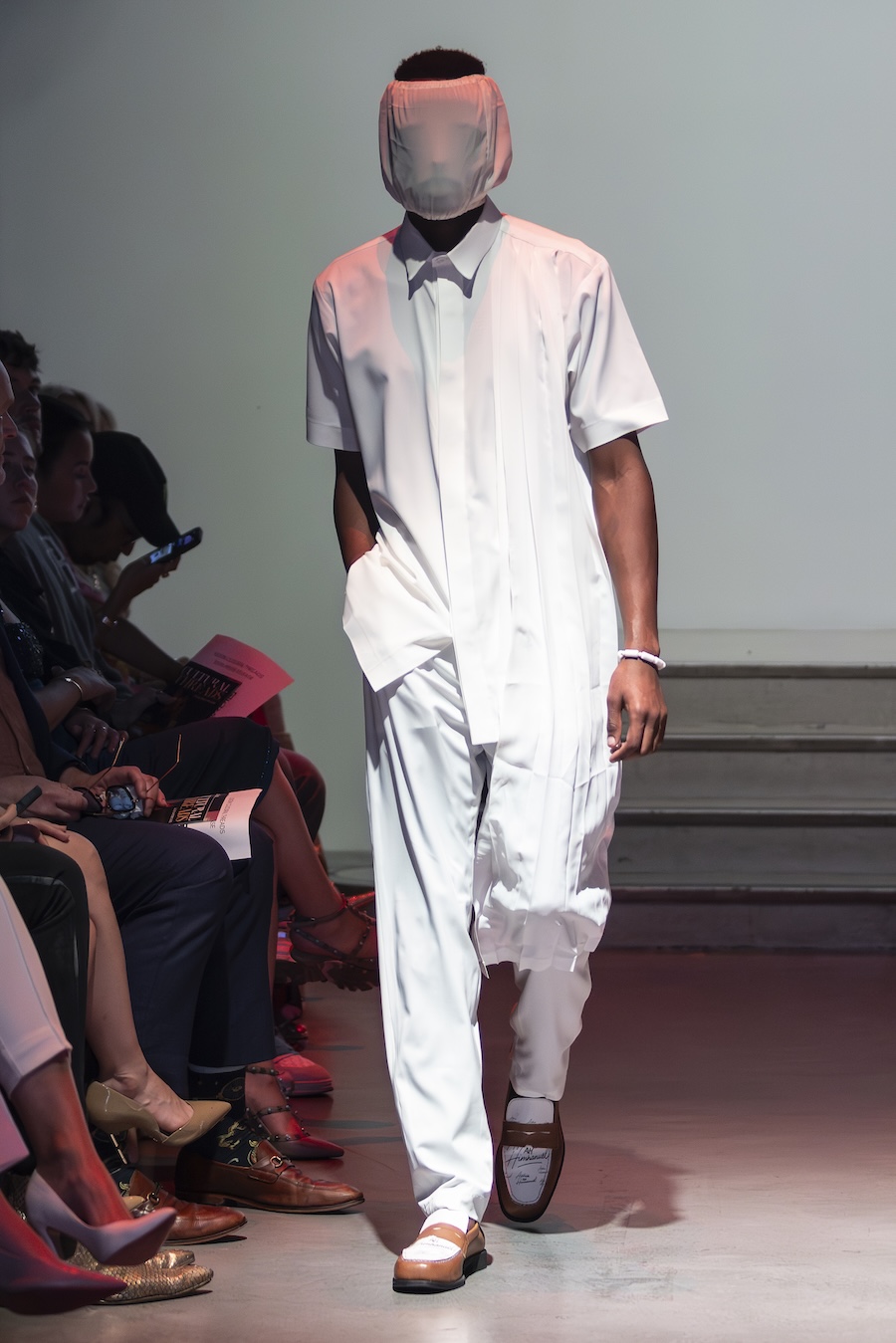
14 designers helped turn London’s Ladbroke Hall into a cultural supernova on Saturday, Sep 20th, as the Unity in Design Global Network (UDGN) staged Cultural Threads SS26, a runway that was more than a show; it was a ceremony, a celebration, and a full-on cultural reset, where clothes became archives, rituals, and living memory.
From spiritual tributes to ancestral flexes, each designer lit the runway with energy that screamed: fashion is culture, fashion is history, fashion is now. Craftsmanship got loud, heritage went technicolour, and minority-led design innovation took centre stage. This wasn’t just another fashion show; it was a new wave of storytelling, where underrepresented designers bent the runway into a canvas for identity, memory, and a new cultural era.
Let’s get into it. Here’s the lowdown on who brought what, and why it mattered.
MOTUNRAYO by Motunrayo Yetunde Ajayi
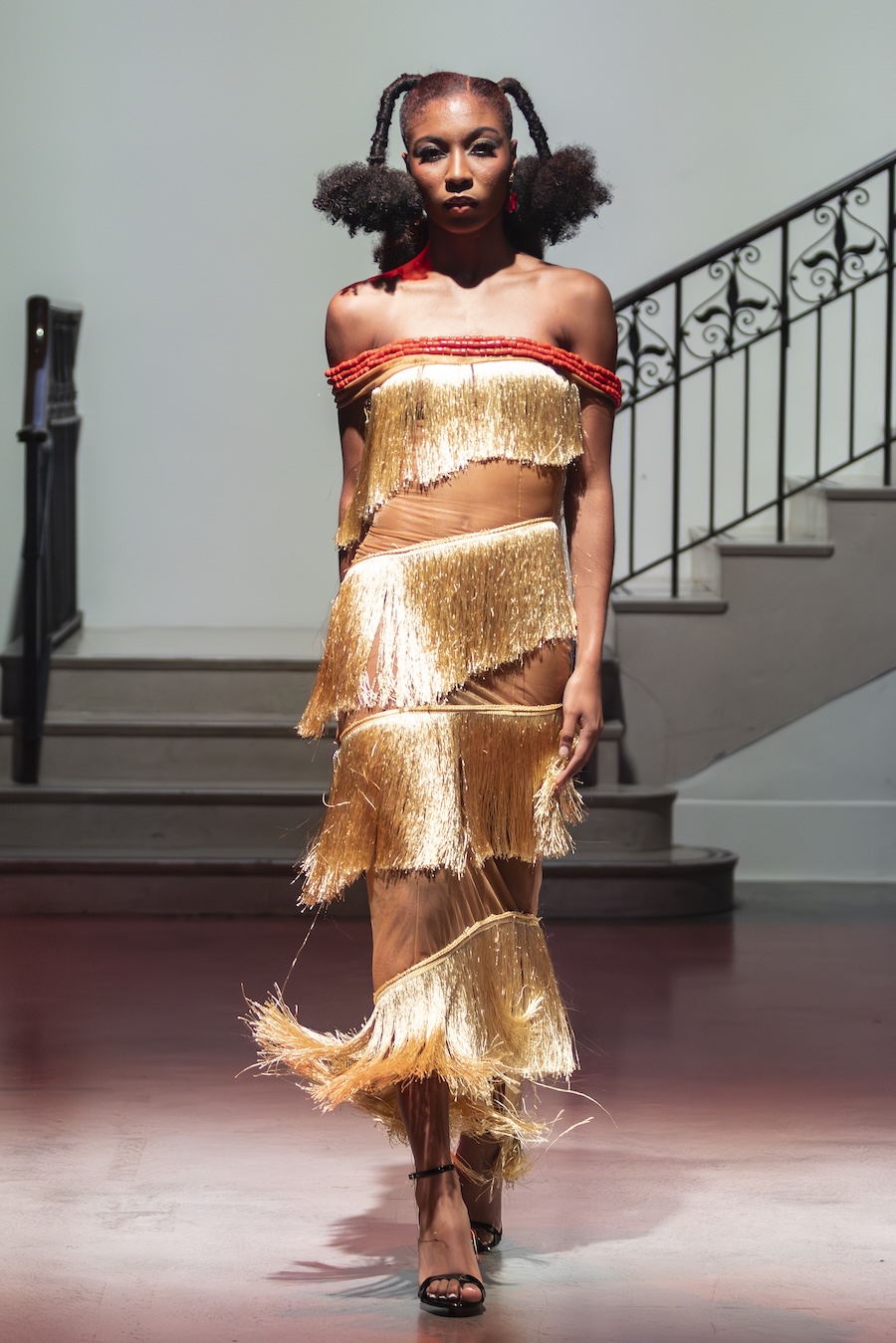
”Of Water and Spirit, “ kicking off with divine femininity, Motunrayo channelled the sacred Osun Festival into flowing silhouettes that dripped with ritualistic grace. Think sacred purity, but make it contemporary couture serving fringe and beads galore. if memory had a wardrobe, it would probably look like Motunrayo’s collection. Of Water and Spirit drips straight from the river goddess Oshun herself, every hem carrying myth.
The show’s holy grail? A cascade of golden fringe drapes the body like liquid sunlight, shimmering with every step. The sheer underlayer keeps it modern and sensual, while the bold red beadwork across the shoulders pulls the whole thing back into the realm of ceremony. It’s part disco shimmer, part sacred offering, clothing that doesn’t just dress the body, but animates it.
The message is clear: this isn’t fashion, it’s ceremony. A reminder that what we wear can hold memory, worship, and spirituality. Motunrayo weaves story into silhouette, summoning ancestry through colour, beadwork, and movement. The earthy palette, tactile details, and sculptural accessories ground the collection, while the movement of each piece lifts it into something ethereal. It reminds us that clothing can transcend adornment, becoming both archive and altar. In Motunrayo’s world, fashion is not only about looking, it’s about remembering, honouring, and summoning. In her hands, adornment becomes language.
AYAH by Ayah Ebimobowei Daukoru
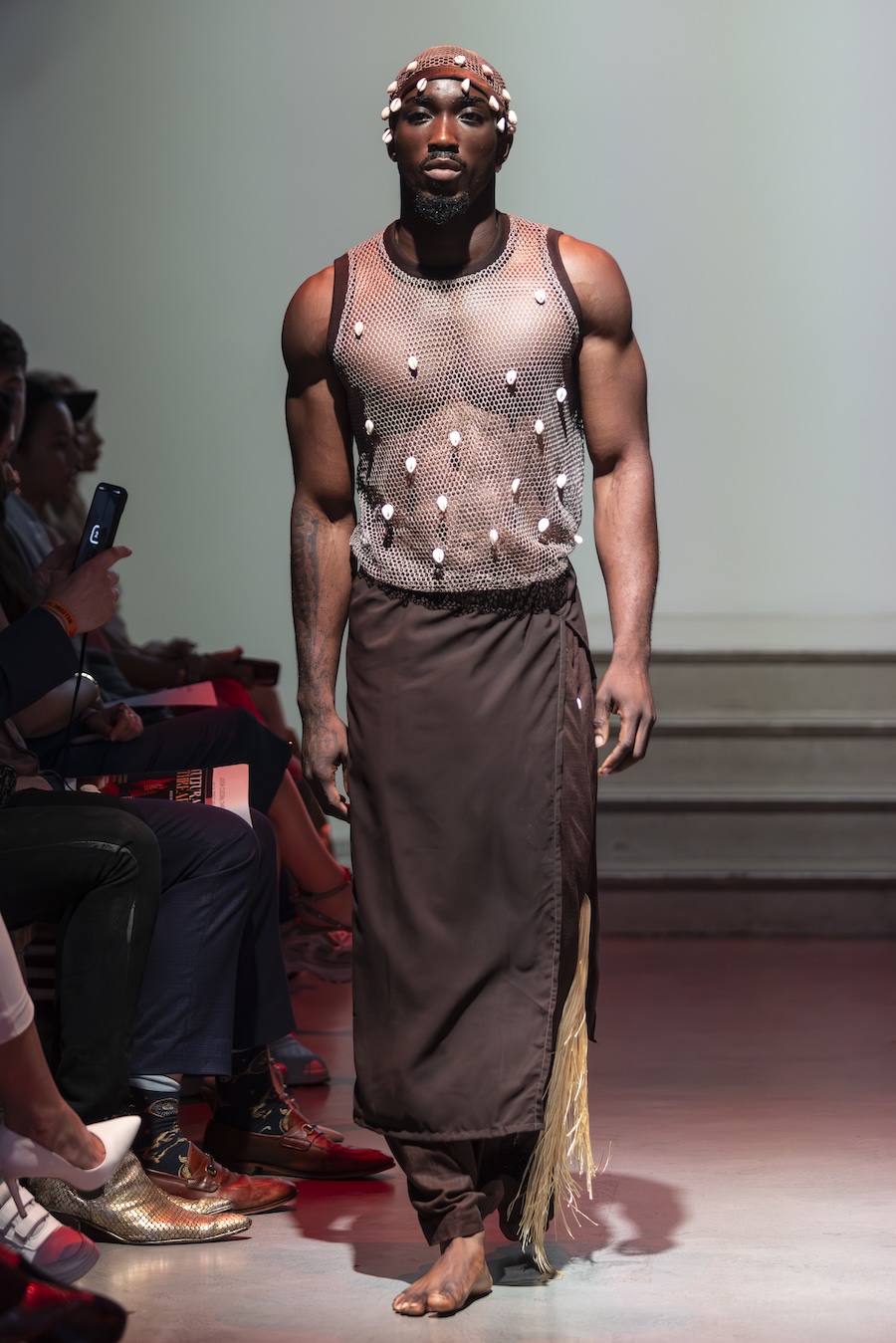
“The Fisherman’s Echo”. Straight from the Niger Delta, Ayah wove riverside textures and tidal rhythms into wearable art. Water wasn’t just inspiration here; it was the beat, the mood, the lifeblood as chocolate browns, shell embroidery, and fishnet mesh swam together fluently. What he gives us isn’t just fashion, it’s a meditation on resilience, on the endurance of people whose lives are tied to muddy rivers and unpredictable tides. The clothes carry that weight.
Ebimobowei Daukoru Ayah flips the usual “Mother Nature” script, showing us resilience through a masculine lens. Think wide-legged trousers that move like waves, fishnet overlays that whisper of wounded ecosystems, and cowrie shell details that feel almost priestly. The earthy greens and browns ground the collection in river silt, but the vibe is more myth than mud. It’s equal parts fisherman, eco-warrior, and sea-god runway fantasy. And we are here for it, menswear soaked in serenity is a mood we can fully endorse.
There’s a quiet power here: silhouettes that feel casual but deliberate, textures that hold stories of labour and survival, fabrics dyed with watermarks like whispers from beneath the surface. Each garment sits at the edge of contradiction, softness and strength, catch and release, grit and grace. In Ayah’s world, polluted waters don’t drown possibilities. They feed it, reminding us that even in the hardest landscapes, new growth is always possible.
ZUBERE by Nancy Chizubere Johnson-Chidiadi

“ULO NWAANYi” Igbo bridal energy, but elevated. This was a homecoming in full technicolour, think structured forms, vibrant fabrics, and a powerful nod to matriarchal legacy with a chic and confident panelled mini dress with an oversized beaded halter detail to boot.
From the very first look, the runway felt less like a stage and more like a threshold into tradition. There was a pulse, an echo, as if somewhere in the distance you could hear drums and feel the stamp of aunties’ feet rising in dust. Her strength lies in her ability to translate heritage into design without losing touch with the contemporary.
Every piece carried the essence of ancestry while remaining firmly modern in silhouette and detail. Layered raffia rippled like dancing skirts, catching air with each step and embodying the energy of communal celebration. Coral embellishments adorned sleeves and necklines, not merely decorative, but deliberate symbols of purity, wealth, and continuity. In her hands, these elements of ceremony were elevated into sculptural statements, deeply rooted yet forward-looking.
Throughout, ZUBERE balanced spectacle with intimacy. The collection was vibrant yet reverent, rich with movement and colour, but also careful in its storytelling. It reminded the audience that fashion can act as both preservation and reinvention, holding memory in its seams while offering new ways to see it. Chizubere doesn’t just design garments; she stages moments where history walks again, alive on the runway. With ZUBERE, she reclaims the bridal procession as more than pageantry. It is heritage, dignity, and power, made tangible in cloth.
MIDETUSH by Olumide Oyewunmi Kolapo
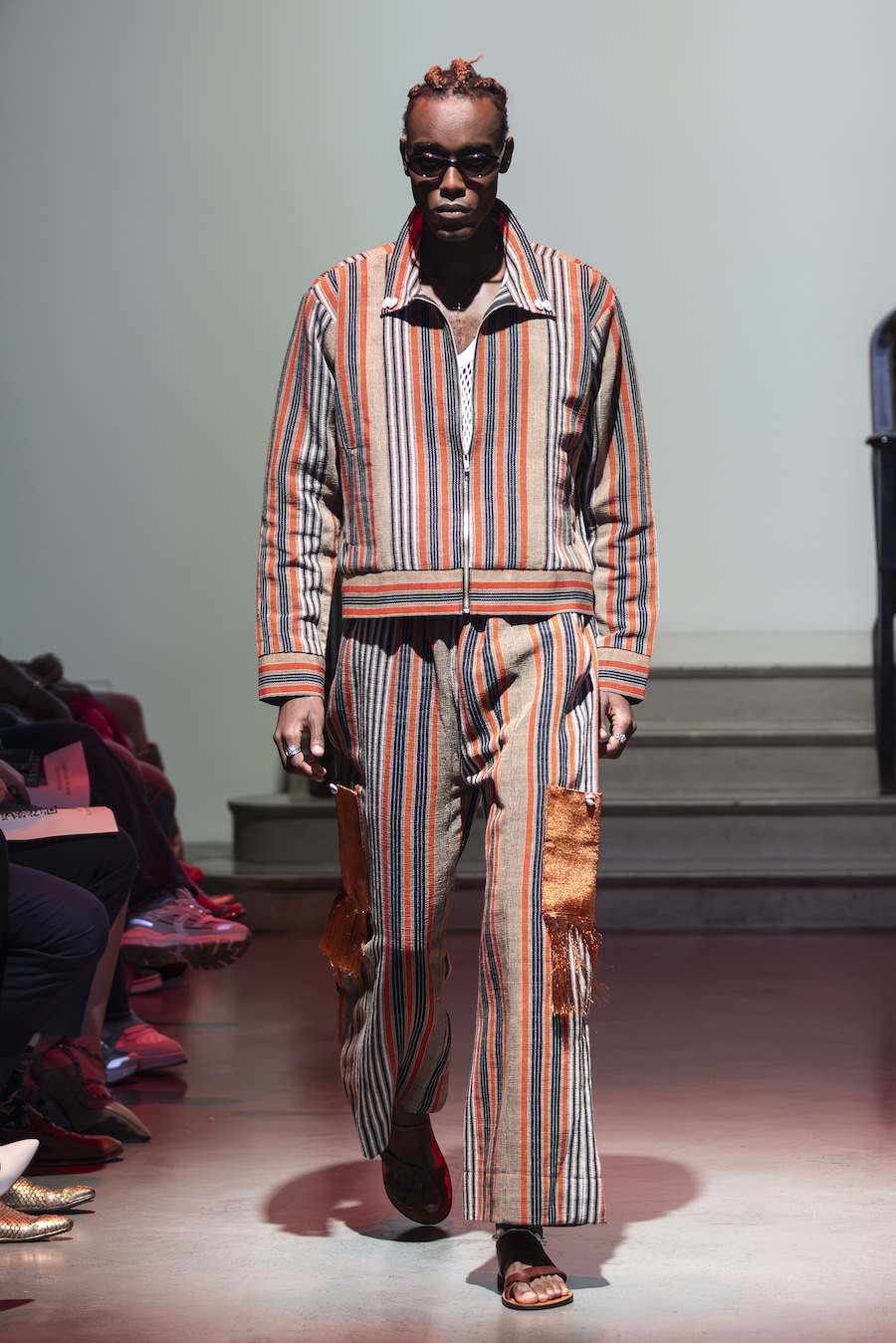
“Air and Stripes” Yoruba heritage met urban swagger in a collection that blurred ancient traditions with street-cool immediacy. His SS26 collection, AFEFE ATI ILA (“air and stripes”), moves like a city breeze, weaving Lagos and London into a single fabric. The result is a body of work that feels both immediate and timeless, a translation of cultural rhythm into clothing that refuses to choose between heritage and modernity.
The silhouettes were oversized yet purposeful, clothes that seemed to breathe. Jackets skimmed the body rather than constraining it, creating space and air while maintaining sharp, deliberate lines. It’s a balance Oyewumi handles deftly: relaxation without slackness, comfort without surrendering polish. The collection captured the sensation of a warm city night, the kind of atmosphere where movement feels endless, where the body leans into rhythm, and the air itself becomes part of the outfit.
The standout moment was a jacket-and-trouser set in orange, blue, and tan stripes, a palette that conjured both desert planes and late August evenings. The stripes created a visual rhythm that pulsed as the model walked, like a song woven into the fabric. Cowrie shells gleamed at the collar, subtle but unmistakable, amulets that connected the global streetwear language back to West African spirituality and history.
Oyewumi refuses to dilute his references; instead, he folds them seamlessly into a vocabulary of global streetwear. The cowries, the stripes, the airy cuts, these weren’t add-ons but integral elements, insisting that identity is not a cost of fashion but its heartbeat.
BOLA by Omobolanle Sulleman

“Inheritance” With Ojude Oba Festival at its heartbeat, this regal collection draped history, pride, and pageantry into modern silhouettes that felt like walking heirlooms. At London Fashion Week, where speed and spectacle often dominate, Omobolanle Sulleman’s BOLA collection offered something radically different: stillness. Her SS26 presentation, Inheritance, was less about chasing the next wave and more about what fashion might look like if it were made not for the season, but for the lineage, garments as heirlooms, binding mother to daughter, past to future.
Drawing inspiration from the Ojude Oba Festival of Ijebuland, Sulleman reimagined festival dress as both celebration and remembrance. Her palette of navy, cornflower blue, and gold unfolded with quiet power: Fabric played the role of storyteller. Aso-Oke, with its centuries-old history of handweaving, became the collection’s anchor. Its textured nobility gave the dresses an inherent dignity, elevating them from clothing into living artefacts. These were not costumes borrowed from heritage, but garments that insisted on being part of it, designed for women who carry history gracefully.
The cropped shirt, with its sharp, sculptural shoulders, feels almost architectural, giving structure without overwhelming the body. Paired with a full, pleated skirt, the look achieves an elegant equilibrium: tailored yet fluid, formal yet wearable. The vertical stripes in navy, cornflower, and gold elongate the figure while carrying a deeper symbolism of solemnity, joy, and reverence.
Each cut seemed to whisper Sulleman’s philosophy: that true luxury is not in novelty, but in intentionality. These pieces were designed to last, to be worn, re-worn, and eventually passed on, like treasured jewellery or family photographs. It was a collection that slowed the audience down, reminding us that fashion’s greatest power may not be reinvention, but remembrance. In a week dominated by noise, her stillness felt nothing short of radical.
KAYPEEFOOTWEARS by Omoyoloye Kolapo Ibiyinka

“APATA – Legacy Underfoot” Footwear, but make it ancestral. Rugged soles, symbolic details, each pair a reminder that heritage is carried one step at a time. Each step echoes Yorubaland’s rugged earth, grounding the wearer in ancestral memory while balancing strength, beauty, and symbolism.
Kolapo Omoyoloye’s SS26 collection for ÀPÁTA is less about footwear as a commodity and more about shoes as testimony. Named after the Yoruba word for “stone,” the collection is rooted in heritage, resilience, and endurance. These are not accessories meant to decorate a look; they are anchors, grounding each model with the weight of history while offering a path forward.
His loafers and mules arrive with a kind of lived-in dignity, as though unearthed from shrines yet instantly wearable in the present. They resist polish for polish’s sake, instead embracing the marks of time, journeys, and ritual. The idea of walking as a rite of passage, young boys becoming men along the rugged paths of Southern Nigeria, is etched directly into the designs. The leather is scored with motifs that echo footprints and rain-worn roads, turning each pair into both map and artefact.
Colour, too, plays a ceremonial role. A standout design in bold yellow and red felt lifted straight from Yoruba festival culture—its palette recalling warrior cloths, ceremonial banners, and the rhythms of processional drums. They carry narrative, but also structure; they look like relics yet function as modern streetwear. Omoyoloye bridges reverence with practicality, crafting pieces that feel ceremonial but never static.
ROBES AND BLINGS BY AKOKOMALI by Olaitan Maria Olatoke
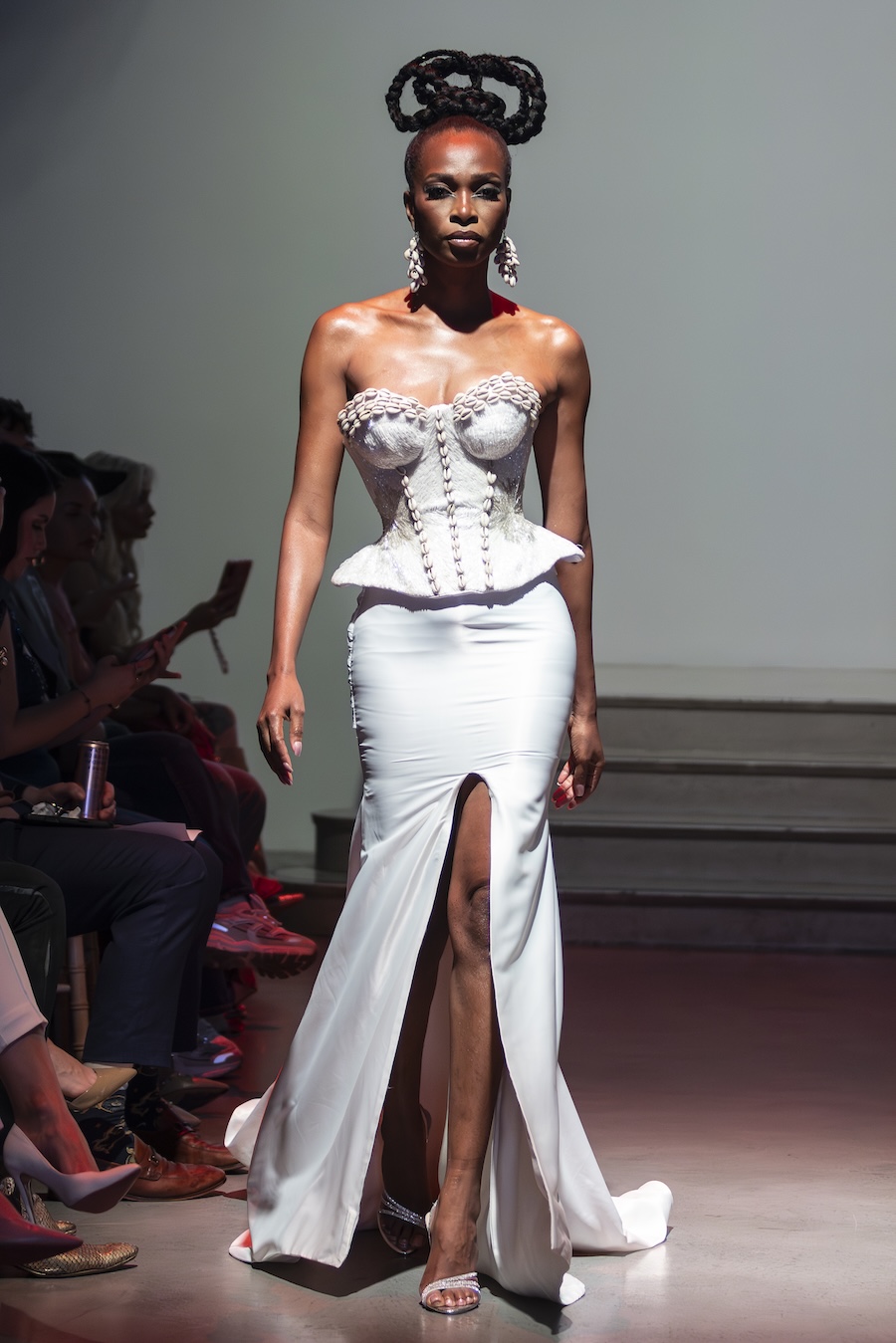
“TIWA N TIWA” Billowing silhouettes danced down the runway, each gown a cloud of delicacy and power, celebrating womanhood in its most extravagant form. Big gowns, bigger energy, floaty, feminine, and dripping with intricate detail, these looks were pure extravagance, everyone a showstopper in their own right. Reclaiming ritual cloth as an emblem of womanhood and defiance. A transformative canvas, where once-judging fabric becomes vocal armour.
The collection opened with a sheer red robe that cascaded into sculptural tulle, a look that immediately set the tone. It was more coronation than preparation, positioning the bride not as someone awaiting transformation but as someone already enthroned. Theatrical, commanding, yet soft in its fluidity, it captured the duality of Olatoke’s vision: grandeur infused with intimacy.
Throughout, cowries and coral beads shimmered across garments, deployed not as decorative excess but as talismanic symbols. Their presence spoke of wealth, protection, and heritage, grounding the collection in Yoruba cosmology while elevating the designs into pieces that felt ceremonial in the truest sense. The sculpted white corset, detailed with cowrie shells that trace its curves, feels both protective and ornamental, an armour of beauty rooted in Yoruba symbolism. Each shell shimmers as a talisman, carrying centuries of meaning: prosperity, fertility, spiritual power.
Ultimately, Olatoke positions the African bride not as subject but as sovereign. RBA insists that bridalwear can be a cultural declaration: a moment to honour ancestry, signal prosperity, and radiate glamour all at once. It offers a vision of bridal fashion that is not only spectacular but resonant, redefining what it means to step into marriage with both style and ceremony.
LEKAN AARE by Lekan Taofeek Folarin
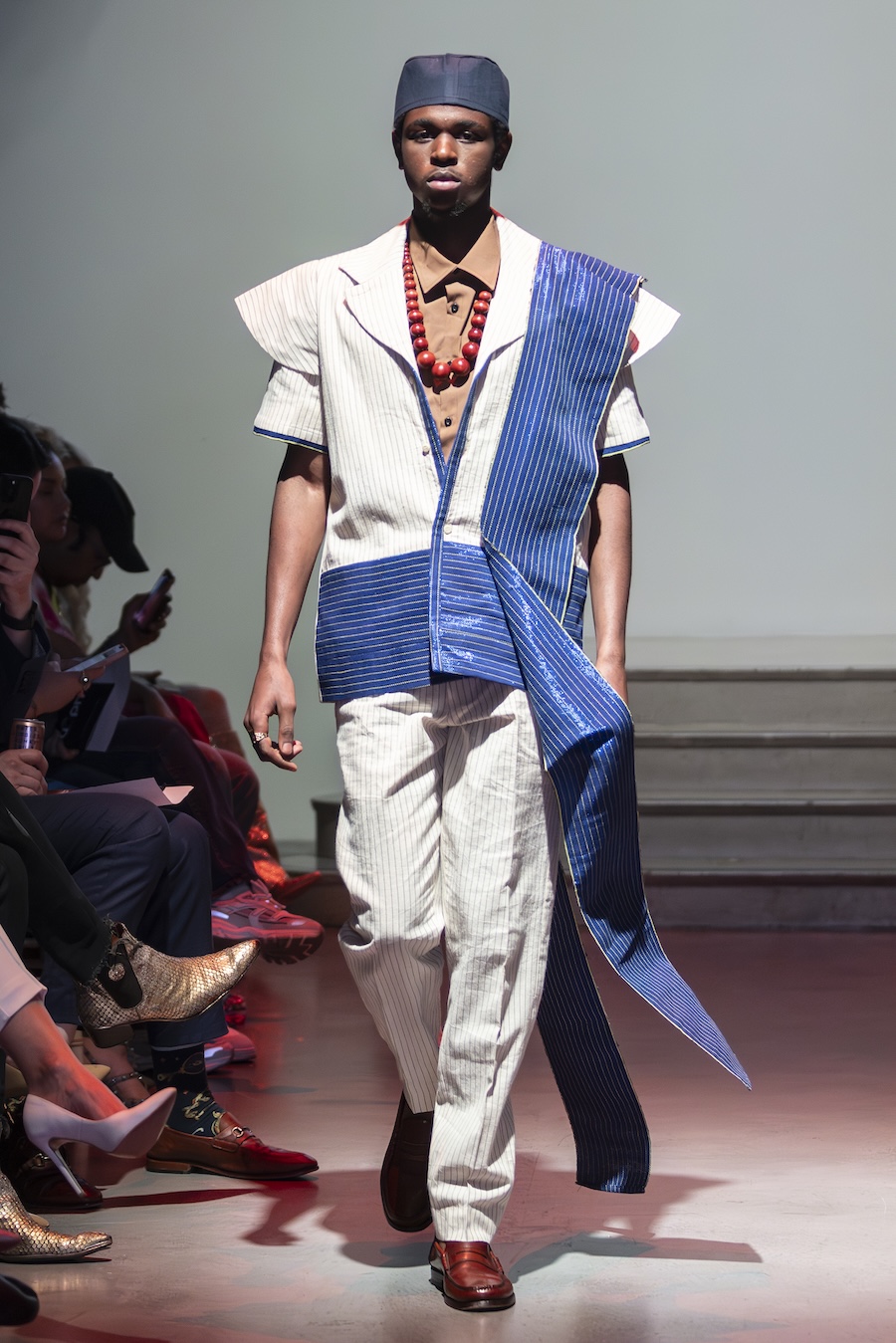
“Homage to the King” Catwalk, but fit for a king. Sharp tailoring and opulent fabrics transformed masculinity into a regal art form. Sharp cuts and luxe fabrics dripping in Yoruba nobility, masculine elegance was sculpted into a new, regal reimagining, where fabric crowns and form commands. Nobility, reloaded for 2025.
Translating to “Homage of the King,” the very name of Lekan’s brand sets the stage for a collection rooted in Yoruba tradition and regal bearing. This is not clothing for everyday; these are coronations tailored into fabric, garments that walk the fine line between ceremony and modernity.
Across the five-look collection, pinstripes emerged as a defining motif. But here they were never corporate, never business-as-usual. Instead, they became royal insignia, bending fluidly to the contours of the body and honouring movement as much as structure. What might otherwise read as a sober textile was reimagined as a marker of dignity and procession.
A standout design came in the form of a white pinstripe suit traced with a single line of royal blue running from shoulder to hem. The detail was subtle yet striking, like a sash of nobility draped across the frame, instantly transforming the model into a figure of authority. Sleeve details fanned outward like butterfly wings, offering sculptural contrast to the suit’s tailored precision.
What Lekan has accomplished is a recalibration of menswear. The sharp lines, inventive detailing, and sculptural proportions make the collection as resonant in a throne room as on a red carpet. Ultimately, Homage of the King is a meditation on dignity. It demonstrates how traditional African tailoring can be both preserved and reimagined.
PEM by Mary Princess Obeya
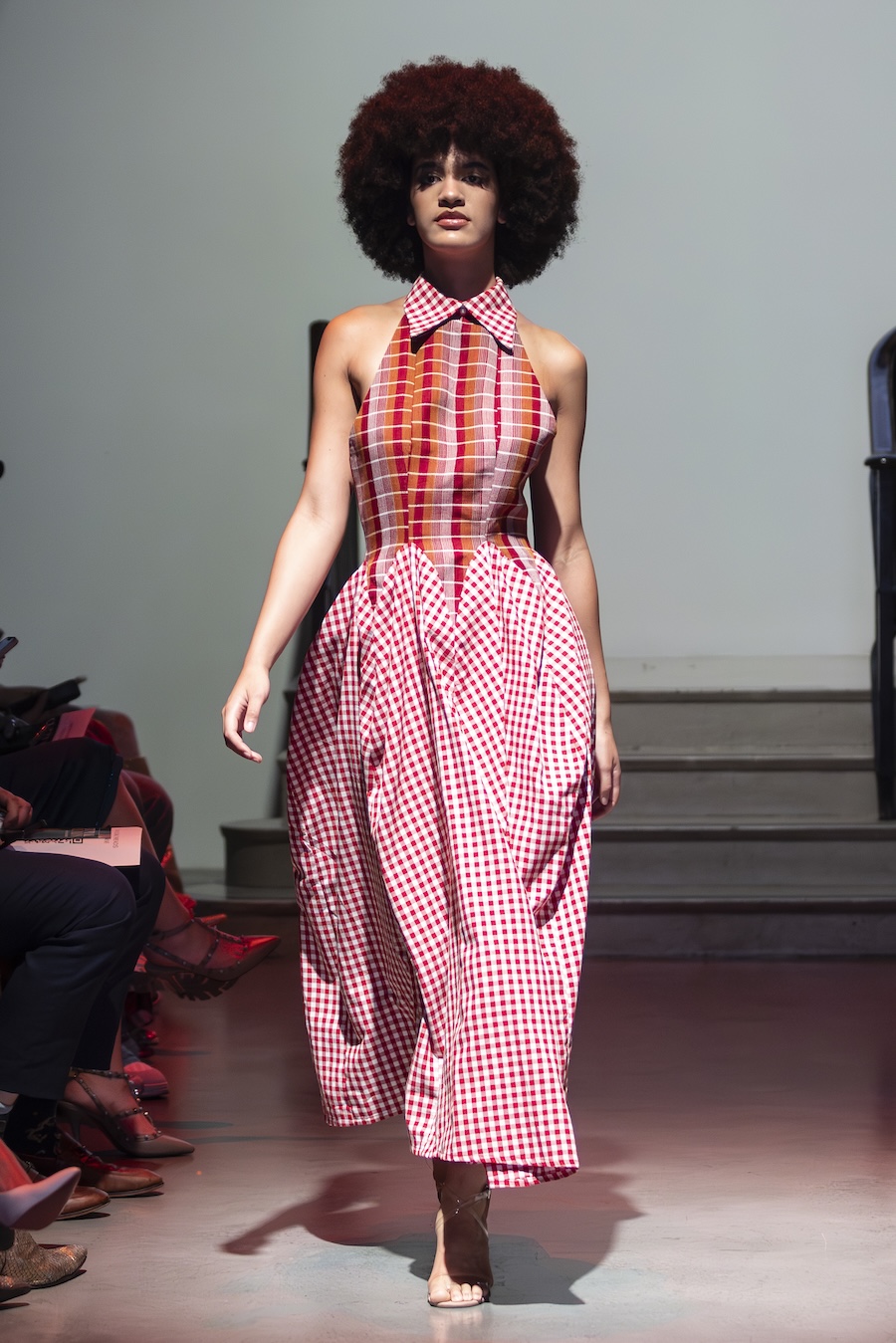
“The Spirit Wears Red” Crimson tones, layered silhouettes, and fierce homage to Idoma women, dancers, mothers, and leaders. A collection that pulsed with generational strength. Fiery, fierce, and full of Idoma pride, the collection was a blazing tribute layered in silhouettes in deep reds, embodying generational power and beauty. Ancestral fire stitched into every fold, burning with memory and grace, and we live for a clashing print moment.
Princess Mary Obeya’s the Spirit Wears Red is less a collection than a living performance, a celebration that captures the pulse of Idoma tradition while reinterpreting it for the modern runway. Drawing from the ceremonial dress of the Idoma people of Benue State, Obeya manages the delicate balance of honouring heritage without fossilising it. What results is a body of work that feels reverent, dynamic, and deeply alive. Red dominated the runway, bold, unrelenting, and rhythmic. In Idoma culture, the colour signifies vitality, passion, and ritual, and here it appeared not as mere fabric dye but as heartbeat.
Fringe, cowries, and sculptural silhouettes animated the collection, their movement transforming the models into dancers mid-ceremony. Each step, each turn of the body activated the designs, giving them a kinetic energy that recalled festival grounds more than fashion week. A standout moment came in the form of a halter-neck gingham dress with a dramatically folded skirt. Constructed from mixed gingham panels, blends the vibrancy of Idoma ceremonial dress with a playful modernity. The structured volume shifted with every stride, creating an interplay of tradition and innovation. The open back added a daring sensuality, reframing sacred attire through a contemporary lens without diminishing its power.
Truly a look that embodied Obeya’s ethos: rooted in culture, yet unafraid of modernity’s gaze. With this collection, Princess Mary Obeya has shown that fashion can be more than homage.
OOMO AJADI by Yusuf Kareem Gbolahan
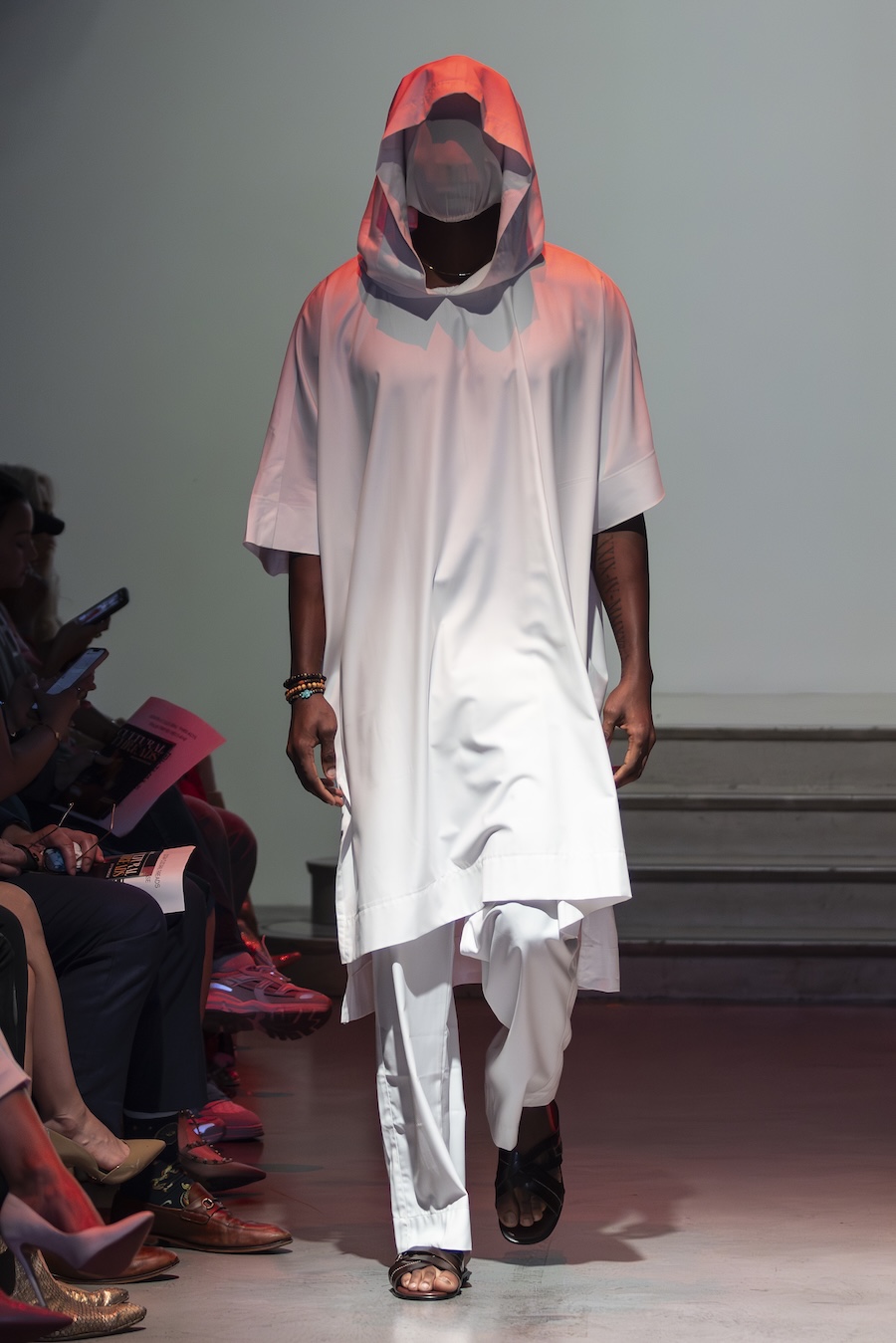
“White Oracle: The Eko Spirit Walk” Yusuf Kareem’s OOMO AJADI collection unfolded like a ritual on the runway, transforming the catwalk into a space of reverence rather than spectacle. Drawing inspiration from the Ẹyọ Masquerade of Lagos Island, Kareem created not merely a fashion show, but a living archive of Yoruba tradition.
Models appeared in pure white, faces veiled, their movements slow and deliberate, figures caught between the realms of the living and the divine. At one point, a model struck the ground with an opá staff, the gesture echoing centuries of ceremony. In Yoruba culture, the staff signifies order, dignity, and authority. Here, it became both performance and invocation, rooting the collection in ritual significance.
The garments themselves were marked by restraint. Lightweight fabrics flowed with air and ease, prioritising breath and movement over embellishment. Yet this simplicity was deceptive: each detail carried the weight of symbolism. The veils, initially unsettling in their anonymity, soon revealed themselves as homage to the masqueraders, spiritual mediators who channel the presence of ancestors. What might appear minimal was, in fact, layered with cultural resonance.
Kareem’s achievement lies in his refusal to reduce tradition to mere aesthetics. Instead, OOMO AJADI treated the runway as a sacred procession, an act of cultural storytelling where absence spoke as loudly as presence. The white fabric became more than a palette choice. It was purity, transcendence, memory. The covered faces disrupted the idea of fashion as personality, insisting instead on collective history.
OBIREEN by Salami Oluwaseun Victoria
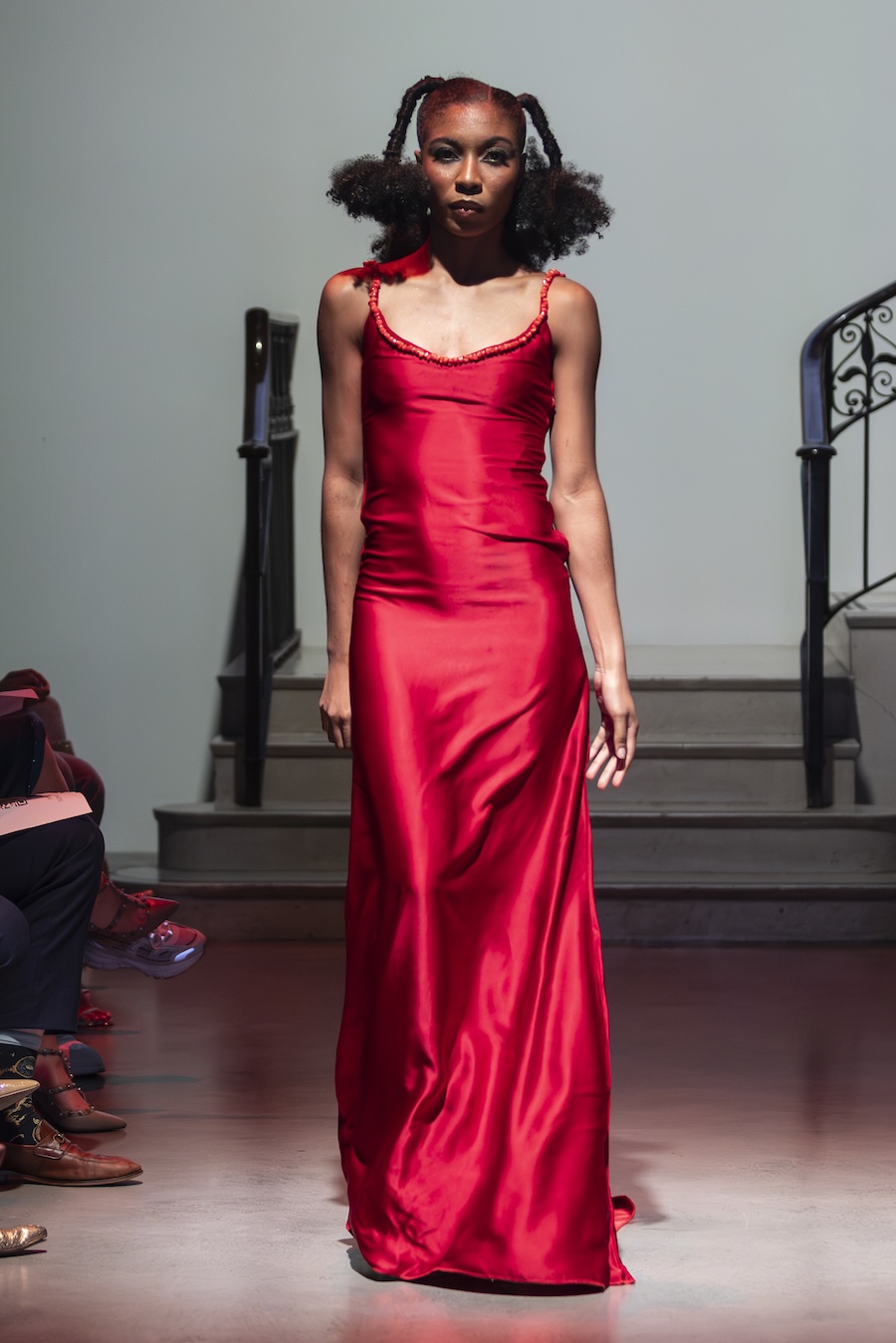
“Okpa n’Iyoba – Strength of a Queen” Channelling Queen Idia of Benin, this was ceremonial grandeur remixed with modern poise. Royal vibes reloaded, Queen Idia’s legacy spun into runway-ready regality, Ceremonial motifs sharpened with modern edge, balancing reverence and reinvention. A queen’s strength reborn in fabric, commanding both past and present. And who doesn’t love a cheeky red silk gown so well constructed and so well fitted it glides like liquid metal on the runway?
From the opening look, strength became the defining motif. Not the brittle strength of conflict, but the expansive, grounded authority of women who take up space unapologetically. Rich coral reds and deep burgundies dominated the palette, evoking the sacred coral beads of Benin’s royal court. Together, they formed a chromatic through-line that made the collection cohesive, deliberate, and steeped in symbolism.
Silhouettes balanced volume and discipline with striking confidence. Sweeping skirts seemed to breathe with the models as they walked, inhaling and exhaling like living organisms. Fitted bodices anchored this expansiveness, adding structure to the drama. Satin fabrics shimmered beneath the lights, transforming the runway into a kind of ceremonial procession.
The beadwork was particularly compelling. Fine and intricate, it appeared not as ornament but as protection, beads tracing along straps and bodices like charms, both beautiful and purposeful. This subtle layering of symbolism underscored Oluwaseun’s vision of couture as narrative: garments that do not just flatter the body, but speak to ancestry and inheritance. OBIREEN was not only a tribute to Queen Idia but also a statement about what it means to design in her shadow.
THE IDEAL CRAFTSMAN by Olutoba Mercy Odetomi
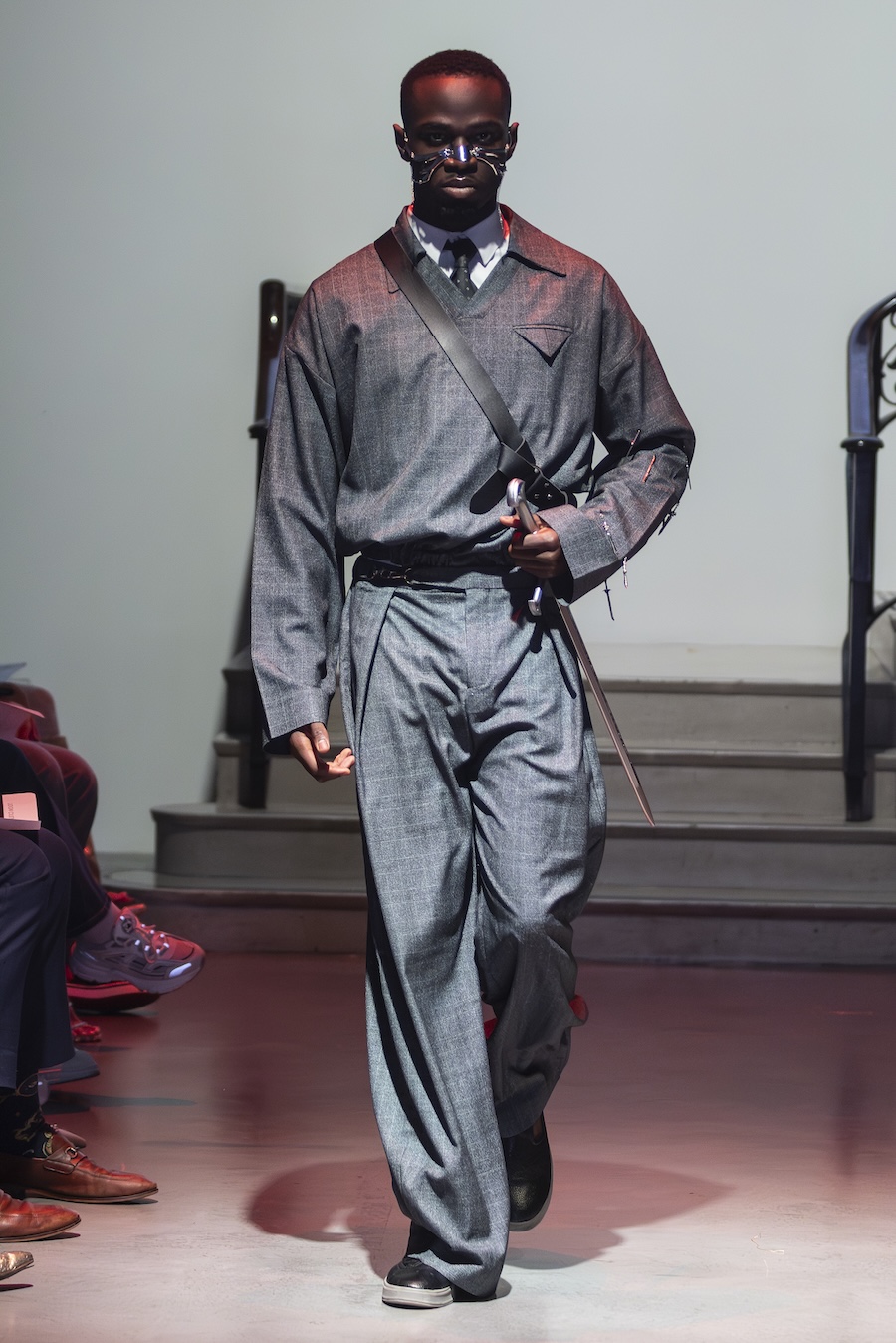
“The Five” Menswear infused with Yoruba spirituality. Each look was a quiet invocation of five orishas, balancing sleek tailoring with symbolic weight.
Olutoba Odetomi’s SS26 collection was a journey into the mythic potential of tailoring, a reminder that even the most familiar garments can become portals when reimagined with precision and imagination. His work occupied a fascinating space between fantasy and structure, where blazers transformed into symbols and tailoring unfolded as narrative.
At first glance, the collection was anchored in refined wardrobe staples: jackets, trousers, coats. But Odetomi treated these not as static templates, but as canvases for reinvention. Weighted bell sleeves swung with theatrical gravity, while angular shoulders sharpened the body into something sculptural, almost otherworldly. The standout was a tailored jacket-and-trouser set adorned with a sword and silver facial jewellery, turning the model into a figure suspended between warrior and prophet. It was menswear reframed as mythology.
What distinguished Odetomi’s vision was his ability to make classic tailoring feel strange again. In a fashion landscape where the suit often risks redundancy, he reminded us of its capacity to surprise. In the end, Odetomi’s SS26 collection lingered because it refused to settle into familiarity.
Some moments edged into science fiction, an all-white ensemble, for instance, that draped around the body like the robes of a futuristic monk or Jedi knight. Yet the sense of whimsy never eclipsed the discipline. Every cut was clean, every seam deliberate. The fantasy was built on a foundation of craft, ensuring that even the most imaginative gestures felt wearable and commanding.
ITELE by Seyi Agboola

“Freedom” With his latest presentation, Agboola dismantled the loafer’s reputation for seriousness and restraint, infusing it with wit, shine, and a distinctly African point of view.
On the runway, the shoes caught the light with irreverent confidence. Embroidered motifs became the language of reinvention: buzzing yellow bees, stacks of money, proud emblems that spoke with equal parts humour and authority. These designs took symbols of labour and wealth and reimagined them as joyful, almost satirical ornaments. It was corporate tradition turned inside out—footwear that felt closer to streetwear in spirit, but still carried the craftsmanship and polish of luxury design.
What lingered most was the unapologetic assurance of the collection. These loafers were not content to be background accessories; they demanded visibility, insisting on participation in a global conversation about where luxury footwear belongs. Agboola’s work made a case that African craftsmanship is not only capable of matching European standards but of surpassing them, bringing fresh vision to a form long bound by tradition. With Itele, Seyi Agboola has repositioned the loafer as more than a staple. He has turned it into a statement, heritage reframed, tradition loosened, and global luxury redefined with African ingenuity at its centre.
TWIN BY TARE ISAAC by Tare Isaac
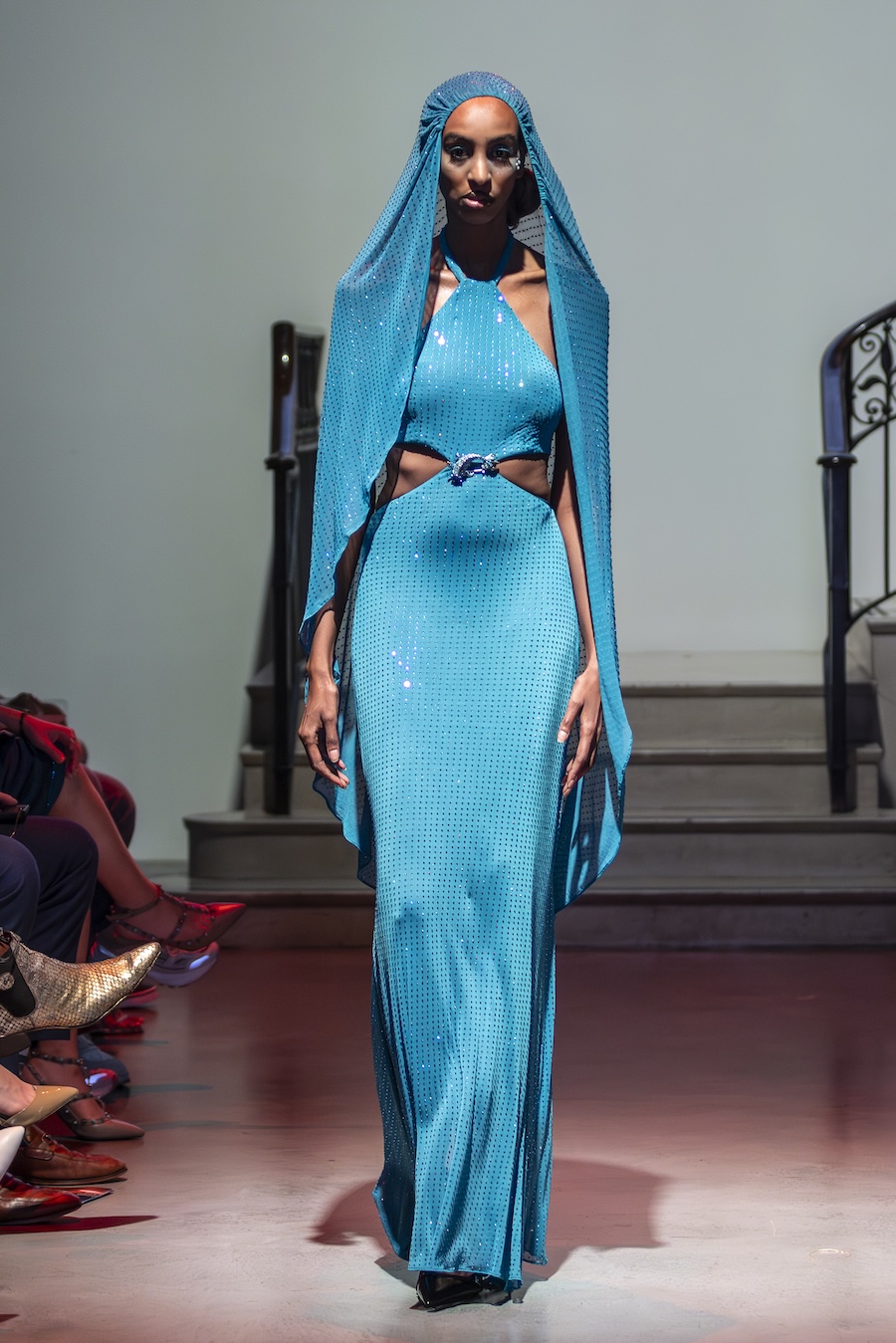
“The Water Bearer” A sensual dialogue between water and womanhood. Every bead, a ripple; every silhouette, a tide, power flowing in motion. TWIN’s The Water Bearers, the latest chapter in Tare Isaac’s ongoing series In My Blood, unfolded like a poem in motion, a meditation on ancestry, memory, and the riverine lifeways of the Ijaw people.
The collection’s palette and textures echoed the shifting moods of a river. A sea-blue gown lined with jewels shimmered as though it had trapped sunlight lapping at the ocean surface. The halter neckline and cut-out waist add a contemporary sharpness, while the knotted detail at the centre recalls the tying of cloth, a gesture both practical and symbolic in many African traditions. The attached hooded drape transforms the silhouette, elongating the figure into something statuesque, almost divine. It frames the model’s face with quiet reverence, evoking priestess, river goddess, or oracle, without ever tipping into costume. The fabric’s soft ripple across the body reinforces the collection’s theme of water as life force and inheritance.
What makes this look compelling is its balance between sensuality and spirituality. The cut-outs and fitted form root it firmly in modern fashion, while the hooded veil and fluid fabric elevate it into the realm of ceremony. It’s a garment that doesn’t just walk a runway; it flows, reminding us that fashion, like water, can carry history, power, and transformation.
The fluid silhouettes and delicate adornments invited the audience to step into the current, to experience not just design but continuity. By rooting contemporary design in the maternal line of the Ijaw people, she positioned fashion as a form of cultural testimony. The Water Bearers was not simply beautiful; it was resonant, each piece a reminder that rivers do not end, they flow into the future.
By the end, it wasn’t just a catwalk, it was a freaking manifesto. UDGN proved that when underrepresented designers tell their stories, the runway becomes something bigger: a canvas for memory, resistance, and the future of fashion itself. This was fashion as invocation, a reminder that lineage can flow through fabric as surely as water through a delta
Words by Lewis Robert Cameron
PR @udgn.global
PR @i.deapr
Showcasing Designers SS26
@shop_motunrayo
@ayahintl
@zu_be_re
@midetushbespoke
@bolasulleman
@kaypeefootwears
@robesandblingsbyakokomali
@lekan_aare
@pem.couture
@oomoajadi
@obireen
@theidealcraftsman
@itele_
@twinbytare
SHOW CREDITS:
MAKEUP:
Loretta Agyemang @luxebylorey
Sarah Agbiji @modernwand
Josephine Blades @allurefacesuk
Amber Wilson @amberwilsonmua
Morẹ́nikẹ́Akinnawonu @madeup.bymo
Ana Rocha @anarocha_makeup_
Sindi Zulu @sindsbeauty
Daniela Le @haiyenglam
Hair:
Cherie Odunayo @cz.beauty
Tinofara @Styledbyteenz
Christabel Okoye @krystals.touch
Toyosi Agbaniyaka @teescrowns
Unity in Design Global Network (UDGN) is a trailblazing fashion platform reimagining the future of fashion by centering the visions, voices, and stories of minority designers across the globe. The platform operates as both a CIC and a Ltd. entity, offering technical support, business development, wellness care, and high-level PR to emerging designers through a unique incubator-to-showcase model.
Founded by award-winning designer and British Fashion Council member Tare Isaac, UDGN builds tangible pipelines for growth and recognition, providing visibility and infrastructure for independent, diaspora-rooted fashion talent. The Cultural Threads showcase marks the debut of UDGN’s flagship incubator program, highlighting 16 designers whose work is deeply embedded in cultural heritage and innovative design.

